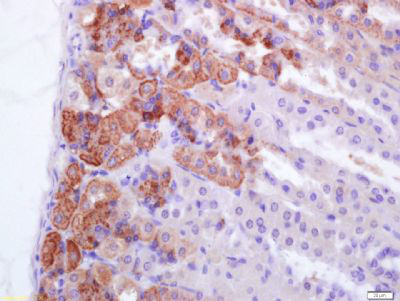产品货号 : mlR8458
英文名称 : PTRF
中文名称 : RNA聚合酶1和转录释放因子抗体
别 名 : Cavin; MGC118550; FKSG13; OTTMUSP00000002049; polymerase I and transcript release factor; RNA polymerase I and transcript release factor; RP23-279L23.6; TTF I interacting peptide 12; 2310075E07Rik; AW546441; PTRF_HUMAN.
研究领域 : 细胞生物 免疫学 表观遗传学
抗体来源 : Rabbit
克隆类型 : Polyclonal
交叉反应 : Human, Mouse, Rat, Dog, Cow, Horse,
产品应用 : ELISA=1:500-1000 IHC-P=1:400-800 IHC-F=1:400-800 IF=1:50-200 (石蜡切片需做抗原修复)
not yet tested in other applications.
optimal dilutions/concentrations should be determined by the end user.
分 子 量 : 43kDa
细胞定位 : 细胞核 细胞浆 细胞膜
性 状 : Lyophilized or Liquid
浓 度 : 1mg/ml
免 疫 原 : KLH conjugated synthetic peptide derived from human PTRF/RNA polymerase I and transcript release factor:81-180/390
亚 型 : IgG
纯化方法 : affinity purified by Protein A
储 存 液 : 0.01M TBS(pH7.4) with 1% BSA, 0.03% Proclin300 and 50% Glycerol.
保存条件 : Store at -20 °C for one year. Avoid repeated freeze/thaw cycles. The lyophilized antibody is stable at room temperature for at least one month and for greater than a year when kept at -20°C. When reconstituted in sterile pH 7.4 0.01M PBS or diluent of antibody the antibody is stable for at least two weeks at 2-4 °C.
PubMed : PubMed
产品介绍 : Pausing of elongation complexes is mediated by the transcription termination factor TTF-I bound to the 'Sal box' terminator downstream of the rDNA transcription unit. PTRF is a Pol I and transcript release factor for dissociation of paused ternary complexes.
Function:
Plays an important role in caveolae formation and organization. Required for the sequestration of mobile caveolin into immobile caveolae. Termination of transcription by RNA polymerase I involves pausing of transcription by TTF1, and the dissociation of the transcription complex, releasing pre-rRNA and RNA polymerase I from the template. PTRF is required for dissociation of the ternary transcription complex.
Subunit:
Interacts with RNA polymerase I and TTF1. Binds the 3' end of pre-rRNA. Interacts with transcription factor ZNF148 (By similarity). Interacts with LIPE in the adipocyte cytoplasm.
Subcellular Location:
Cell membrane; caveola (surface). Cell membrane. Microsome. Cytoplasm; cytosol. Mitochondrion. Nucleus. Also found in the plasma membrane, microsomal and cytosolic fractions and at a low level in the mitochondrial and nuclear fractions.
Post-translational modifications:
Phosphorylated. Present in active and inactive forms. Changes in phosphorylation pattern may alter activity (By similarity).
Five truncated forms are found in the caveolae. These are thought to be the result of proteolysis and may be phosphorylation-dependent.
DISEASE:
Defects in PTRF are the cause of congenital generalized lipodystrophy type 4 (CGL4) [MIM:613327]. It is a disorder characterized by the association of congenital generalized lipodystrophy with muscular dystrophy and cardiac anomalies. Congenital generalized lipodystrophy is characterized by a near complete absence of adipose tissue, extreme insulin resistance, hypertriglyceridemia, hepatic steatosis and early onset of diabetes.
Similarity:
Belongs to the PTRF/SDPR family.
SWISS:
Q6NZI2
Gene ID:
284119
Database links:
UniProtKB/Swiss-Prot: Q6NZI2.1
Important Note:
This product as supplied is intended for research use only, not for use in human, therapeutic or diagnostic applications.
产品图片












